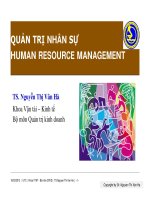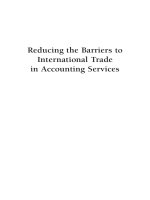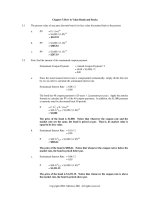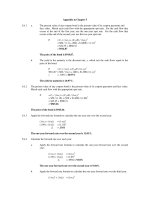Chapter 5 International Trade Theory
Bạn đang xem bản rút gọn của tài liệu. Xem và tải ngay bản đầy đủ của tài liệu tại đây (391.67 KB, 65 trang )
Global Business Today 6e
by Charles W.L. Hill
McGraw-Hill/Irwin
Copyright © 2009 by The McGraw-Hill
Companies, Inc. All rights reserved.
Chapter 5
International
Trade Theory
Introduction
International trade theory
explains why it is beneficial for countries to
engage in international trade
helps countries formulate their economic
policy
explains the pattern of international trade in
the world economy
5-3
An Overview of Trade Theory
Question: What is free trade?
Free trade refers to a situation where a
government does not attempt to
influence through quotas or duties what
its citizens can buy from another country
or what they can produce and sell to
another country
5-4
An Overview of Trade Theory
Question: How has international trade theory
evolved?
Mercantilism (16th and 17th centuries) promoted
the idea of encouraging exports and
discouraging imports
In 1776, Adam Smith promoted the idea of
unrestricted free trade
In the 19th century, David Ricardo built on Smith
ideas, and in the 20th century, Eli Heckscher and
Bertil Ohlin refined Ricardo’s work
5-5
The Benefits of Trade
Question: Why is it beneficial for countries to
engage in free trade?
The theories of Smith, Ricardo and HeckscherOhlin show why it is beneficial for a country to
engage in international trade even for products
it is able to produce for itself
International trade allows a country to specialize
in the manufacture and export of products that
can be produced most efficiently in that country,
and import products that can be produced more
efficiently in other countries
5-6
The Pattern of
International Trade
International trade theory helps explain trade
patterns
Some patterns of trade are fairly easy to
explain - it is obvious why Saudi Arabia
exports oil, Ghana exports cocoa, and Brazil
exports coffee
But, why does Switzerland export chemicals,
pharmaceuticals, watches, and jewelry?
Why does Japan export automobiles,
consumer electronics, and machine tools?
5-7
The Pattern of
International Trade
Ricardo’s theory of comparative advantage
suggests that existing trade patterns are related
to differences in labor productivity
Heckscher and Ohlin’s theory explains trade
through the interplay between the proportions in
which the factors of production are available in
different countries and the proportions in which
they are need for producing particular goods
Ray Vernon suggested that trade patterns could
be explained by looking at a product’s life cycle
5-8
The Pattern of
International Trade
Paul Krugman developed new trade theory
which suggests that the world market can only
support a limited number of firms in some
industries, and so trade will skew toward those
countries that have firms that were able to
capture first mover advantages
Michael Porter focused on the importance of
country factors to explain a nation’s dominance
in the production and export of certain products
5-9
Trade Theory
and Government Policy
While the theories all suggest that trade is
beneficial, they lack agreement in their
recommendations for government policy
Mercantilism makes a case for government
involvement in promoting exports and limiting
imports
Smith, Ricardo, and Heckscher-Ohlin
promote unrestricted free trade
New trade theory and Porter justify limited
and selective government intervention to
support the development of certain exportoriented industries
5-10
Mercantilism
Mercantilism (mid-16th century) asserted that it
is in a country’s best interest to maintain a trade
surplus, to export more than it imports
it advocated government intervention to
achieve a surplus in the balance of trade
it viewed trade as a zero-sum game (one in
which a gain by one country results in a loss
by another)
Mercantilism is problematic and not
economically valid, yet many political views
today have the goal of boosting exports while
limiting imports by seeking only selective
liberalization of trade
5-11
Absolute Advantage
In 1776, Adam Smith attacked the mercantilist
assumption that trade is a zero-sum game and
argued that countries differ in their ability to
produce goods efficiently, and that a country
has an absolute advantage in the production of
a product when it is more efficient than any
other country in producing it
According to Smith, countries should specialize
in the production of goods for which they have
an absolute advantage and then trade these
goods for the goods produced by other
countries
5-12
Absolute Advantage
Assume that two countries, Ghana and South
Korea, both have 200 units of resources that
could either be used to produce rice or cocoa
In Ghana, it takes 10 units of resources to
produce one ton of cocoa and 20 units of
resources to produce one ton of rice
So, Ghana could produce 20 tons of cocoa
and no rice, 10 tons of rice and no cocoa, or
some combination of rice and cocoa
between the two extremes
5-13
Absolute Advantage
In South Korea it takes 40 units of resources
to produce one ton of cocoa and 10
resources to produce one ton of rice
So, South Korea could produce 5 tons of
cocoa and no rice, 20 tons of rice and no
cocoa, or some combination in between
Ghana has an absolute advantage in the
production of cocoa
South Korea has an absolute advantage
in the production of rice
5-14
Absolute Advantage
Without trade
Ghana would produce 10 tons of cocoa and
5 tons of rice
South Korea would produce 10 tons of rice
and 2.5 tons of cocoa
If each country specializes in the product in
which it has an absolute advantage and trades
for the other product
Ghana would produce 20 tons of cocoa
South Korea would produce 20 tons of rice
5-15
Absolute Advantage
Suppose
Ghana could trade 6 tons of cocoa to South
Korea for 6 tons of rice
After trade
Ghana would have 14 tons of cocoa left, and
6 tons of rice
South Korea would have 14 tons of rice left
and 6 tons of cocoa
Both countries gained from trade
5-16
Absolute Advantage
The Theory of Absolute Advantage
5-17
Absolute Advantage
Absolute Advantage and the Gains from
Trade
5-18
Comparative Advantage
In 1817, David Ricardo explored what might
happen when one country has an absolute
advantage in the production of all goods
According to Ricardo’s theory of comparative
advantage, it makes sense for a country to
specialize in the production of those goods that
it produces most efficiently and to buy the
goods that it produces less efficiently from other
countries, even if this means buying goods from
other countries that it could produce more
efficiently itself
5-19
Comparative Advantage
Assume
Ghana is more efficient in the production of
both cocoa and rice
In Ghana, it takes 10 resources to produce
one tone of cocoa, and 13 1/3 resources to
produce one ton of rice
So, Ghana could produce 20 tons of cocoa
and no rice, 15 tons of rice and no cocoa, or
some combination of the two
5-20
Comparative Advantage
In South Korea, it takes 40 resources to
produce one ton of cocoa and 20 resources
to produce one ton of rice
So, South Korea could produce 5 tons of
cocoa and no rice, 10 tons of rice and no
cocoa, or some combination of the two
If each country specializes in the
production of the good in which it has a
comparative advantage and trades for
the other, both countries will gain
5-21
Comparative Advantage
With trade
Ghana could export 4 tons of cocoa to South
Korea in exchange for 4 tons of rice
Ghana will still have 11 tons of cocoa, and 4
additional tons of rice
South Korea still has 6 tons of rice and 4
tons of cocoa
5-22
Comparative Advantage
The Theory of Comparative Advantage
5-23
Classroom Performance System
Which theory did not suggest that there
could be gains from specialization and
trade?
a) Mercantilism
b) Absolute advantage
c) Comparative advantage
d) Heckscher-Ohlin theory
5-24
The Gains from Trade
The theory of comparative advantage
argues that trade is a positive sum gain
in which all gain
Potential world production is greater with
unrestricted free trade than it is with
restricted trade
The theory of comparative advantage
provides a strong rationale for
encouraging free trade
5-25









